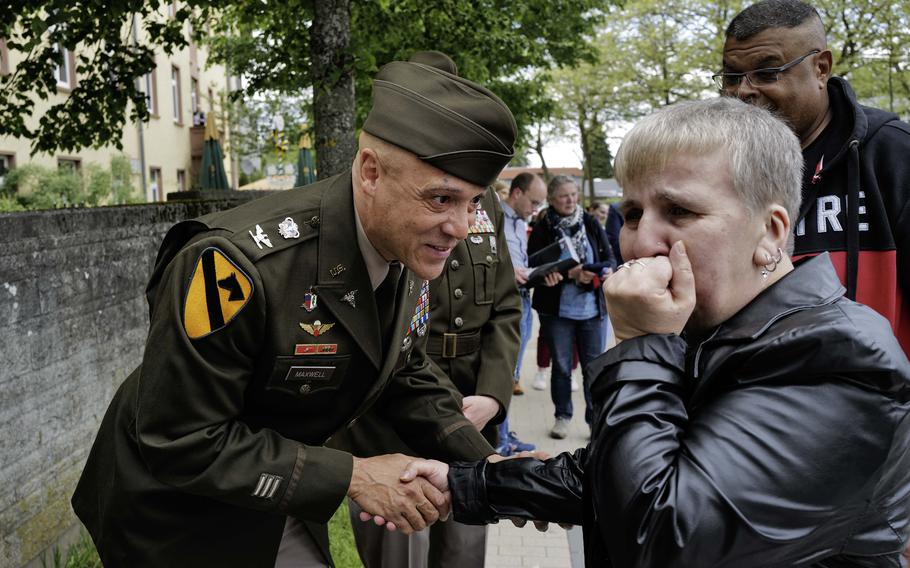
Marina Hilbert receives a challenge coin from U.S. Army Col. Deon Maxwell in Pirmasens, Germany, on Wednesday, May 8, 2024, in recognition of her efforts to connect veterans through her Facebook group. Maxwell is the commander of U.S. Army Medical Materiel Center-Europe, which once operated a depot in Pirmasens. (Alexander Riedel/Stars and Stripes)
PIRMASENS, Germany — American veterans are reconnecting with their long-ago service at Husterhöh Kaserne through a stop on an audio tour that was inspired by a social media group named for the former U.S. military base in Pirmasens.
City officials, veterans and residents gathered Wednesday at the old barracks hall, dubbed “the banana building” on account of its crescent shape, to launch the tour, which encapsulates both the American and German legacies of the site.
The audio tour features 19 steles with etched QR codes at historical sights in Pirmasens. The new Husterhöh stop on the route is the only bilingual one out of the 19.
Voiced by local German-American teen Gisela Looper and retired U.S. soldier Kenny Coleman, it tells of the area’s transformation from a military hub to a thriving civilian community.
It took shape from interactions in the Facebook community “Husterhoeh Kaserne,” connecting former U.S. military personnel who were stationed at the base, city officials said.
Marina Hilbert, a German citizen and the group’s administrator, said her journey began with social media searches for long-lost American friends who had left Germany decades earlier after their tour of duty.
Sharing photos of old haunts evoked memories for many veterans, Hilbert explained, and she was drawn in by their fond memories of Pirmasens.
“Then questions quickly followed from the vets online: ‘Is my building still there?’ or ‘What about my landlords, are they still alive?’ ” she said. “And I just tried to help where I could.”
Today, the group of more than 1,800 members also supports a unique initiative known as the “care call” program.
Group members regularly contact listed members to check on their well-being. If a veteran doesn’t respond, the community takes further steps, with a volunteer checking in personally to ensure everything is OK.
Many members are aging, so the care call ensures that they remain connected and supported, maintaining a lifeline of support and camaraderie, she said.
The bilingual audio guide is a joint effort between group members, city officials, the Pirmasens Youth Forum and the Pirmasens Historical Association.
It explores the local military history and also delves into the area’s culture and vernacular, which made an impact on veterans. One such word is “grumbeere,” or “ground berries,” the local name for potatoes.
Looper, whose parents work at Landstuhl Regional Medical Center, noted the curiosity aroused by the American legacy, which lingers in the city’s street names.
“I like to think about how confused some random German bureaucrats must be when they read about ‘Delaware Avenue’ on a letter, rather than the German words for street and alley,” she said. “Maybe the street addresses will pique people’s interest to find out more, and that is what the audio guide is here for.”
Built in 1938, the barracks initially served the Hitler Youth and were a training ground during the war, the guide explains. The site was handed over to the Americans by the French in March 1951.
Over the decades, it expanded to approximately 750 acres, hosting more than 10,000 American soldiers and their families by the 1990s.
Among the Cold War veterans who reconnected via the Facebook group is Rufus Riley, who served as a missile crewman in Pirmasens under the 2/56 Air Defense Artillery for 10 years starting in 1972.
Riley, an African American who arrived as a young man amid the Vietnam War and rising racial tensions, said he’d heard about neo-Nazis before arriving in Germany.
“When I arrived, I saw large groups with flags and I thought they were already demonstrating,” he recalled. “But what it was, they were going to a soccer game. That was a relief!”
This initial misunderstanding marked the beginning of his deep connection with the city, where he would meet his future wife and become an active sports coach.
Following a scale-down of the U.S. military presence in 1997, the area faced economic challenges, leading to an urban development agreement in 1999 aimed at revitalizing the site for civilian use.
Edith Allison, who served at the base as an intelligence analyst from 1978 to 1981, returned to Germany a few years ago as a Department of Defense Education Activity teacher.
“Pirmasens was my first time this far away from home and has a special place in my heart,” she said. “When I came back for the first time in 2019, they were knocking down some of the buildings, and I thought it was dying.
“But there is a spark of life in that post,” she said. “It’s pretty cool.”
Only a small U.S. Air Force logistics facility today remains amid a shrinking presence of the former base.
“My Americans, my family as I call them, are always sad when they see the old buildings on post. But the buildings never were the Husterhöh,” Hilbert said. “It was always the people. Without them, there would be no Husterhöh.”